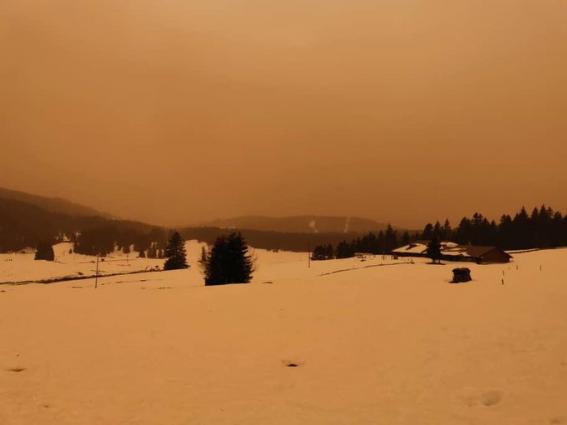Last week, huge plumes of dust covered large parts of Europe, lowering the air quality and hindering the path of sunlight. These winds generally move during late Spring and happen to affect Europe, the US, and South America.
Several parts of Europe are reeling under a thick blanket of dust that has seemingly choked a considerable portion of the continent. Large plumes of dust from the Sahara desert have travelled from Africa to Europe giving skies an orange tint, lowering the air quality across multiple countries.
The recent sandstorm that originated from Algeria in Northern Africa has given a major start to this inter-continental dust-storm that has swept the snow-clad mountains and grasslands of Europe. Most parts of southern and eastern Europe have got Mars-like sky with a reddish effect on the horizon.
According to data extrapolated by Copernicus Atmosphere Monitoring Service (CAMS), these winds from the Sahara desert travel as far as to the US, Caribbean Islands, Scandinavian nations, and Japan. With the advancement of weather forecast systems, these dust-storms are being easily tracked and predicted well before the commencement.
Most of the particles suspended in these dust-storms are PM10 particles which are known to pose and aggravate various health and breathing hazards. As the wind gathers more speed, the settlement of PM10 particles in the affected regions lowers visibility along with hindering the path of sunlight.
From February 4 to February 8, the quantity of particulate matter increased by several micrograms in the air across Europe as this dust storm enshrouded large areas of the European nations.
Dust-storms from Sahara
Dust emerging from the Sahara desert is also known as ‘Aeolian Dust’ where this dust plays a crucial role in controlling the whole ecosystem of carrying nutrients and minerals into the atmosphere and oceanic systems around the world. Also, this dust makes up over half of all the nutrients that go to the oceans.
Generally, this Saharan air forms a layer that resembles a pancake of dry hot air usually having a distance of a mile from the Earth’s surface. During summer, the dust from the desert gets dispersed while cooler air further speeds up the transit process of these articles which remains suspended in the air for days and weeks.
Other than this, the hazards of these dust-laden storms are often palpable in West Africa which lies on the way of the storm. Various studies have proven that the amount of dust present in the air also determines the chance of survival of a baby after birth. A 25 percent increase in dust drastically reduces the survival chances of a baby by almost 18 percent.
Formation of dust-storms
The dust-storms are formed by the development of a subtropical high-pressure system over north-west Africa which creates long-lasting northeasterlies. Also, due to low-level convergence over inter-tropical regions the dust gets lifted up.
As Sahara is a desert that holds coarse particles and specks of dirt in the air, they mostly remain embedded in the atmosphere over there. Due to Sahara’s topography, it is surrounded by the forests of the Gulf of Guinea in the South and that is why air over the southern portion of Sahara remains cooler and humid while that over the northern portion remains relatively hotter. This sets up the air circulation which eventually becomes very strong and finally moves towards the west from the east.
Benefits of dusty winds
It is important to note that these dust storms also provide crucial nutrients to the Amazon basin in South America. As per a study in 2014, around 71 to 87 percent of the iron in the Atlantic ocean comes from the Sahara desert. In 2020, a similar kind of situation arose in Puerto Rico as it got covered from the sandy winds and dust particles.
Besides this, the dust also carries iron and phosphorus which helps in providing required nutrients to plants and phytoplankton present in the ocean. As dust falls on the land and in the ocean the plants received the required materials for photosynthesis. In this way, this dust-storms help in maintaining the cycle of nature. Also, these dusty winds mitigate and hamper the formation of cyclones as they suck out the humid essence from them.
‘

